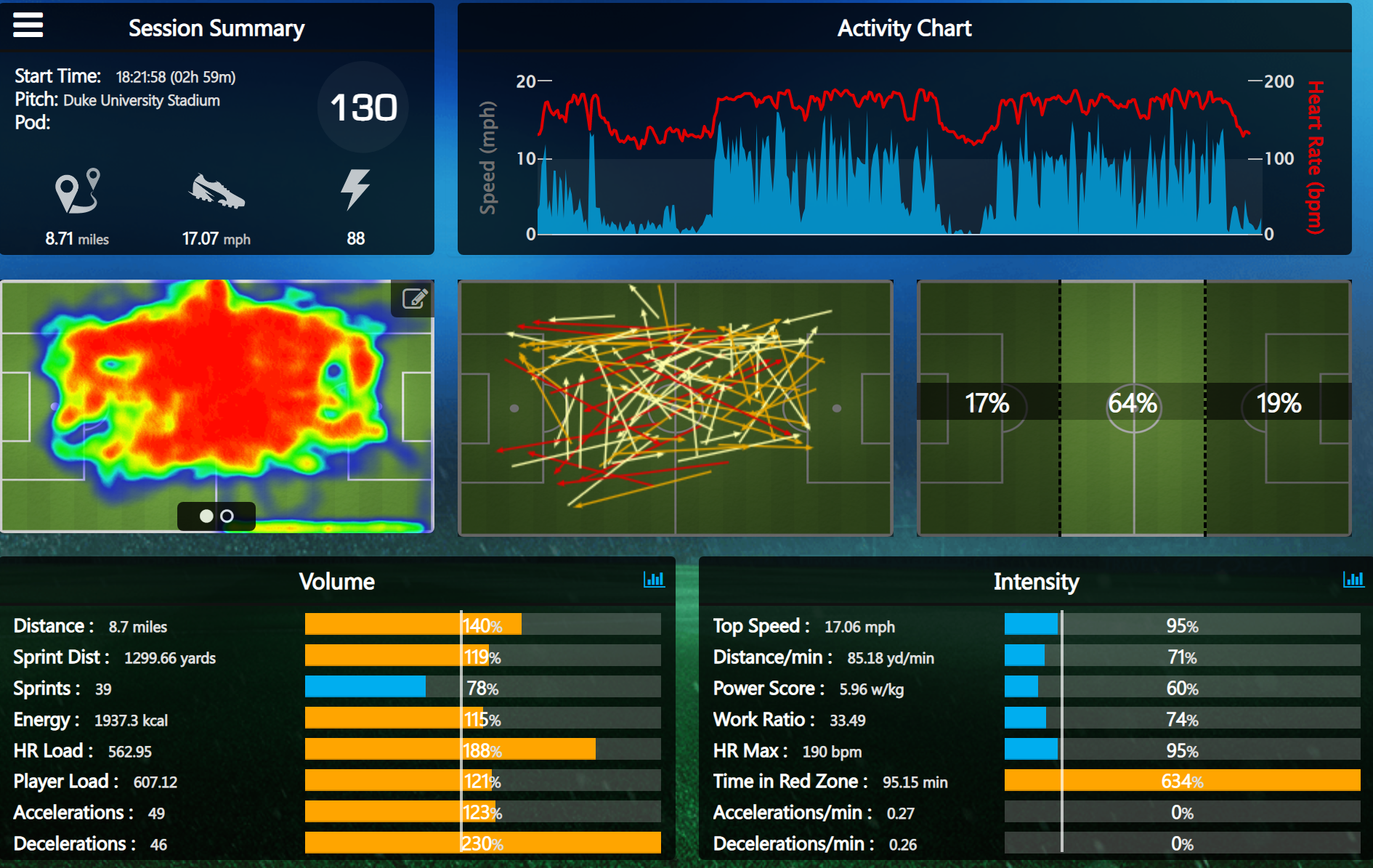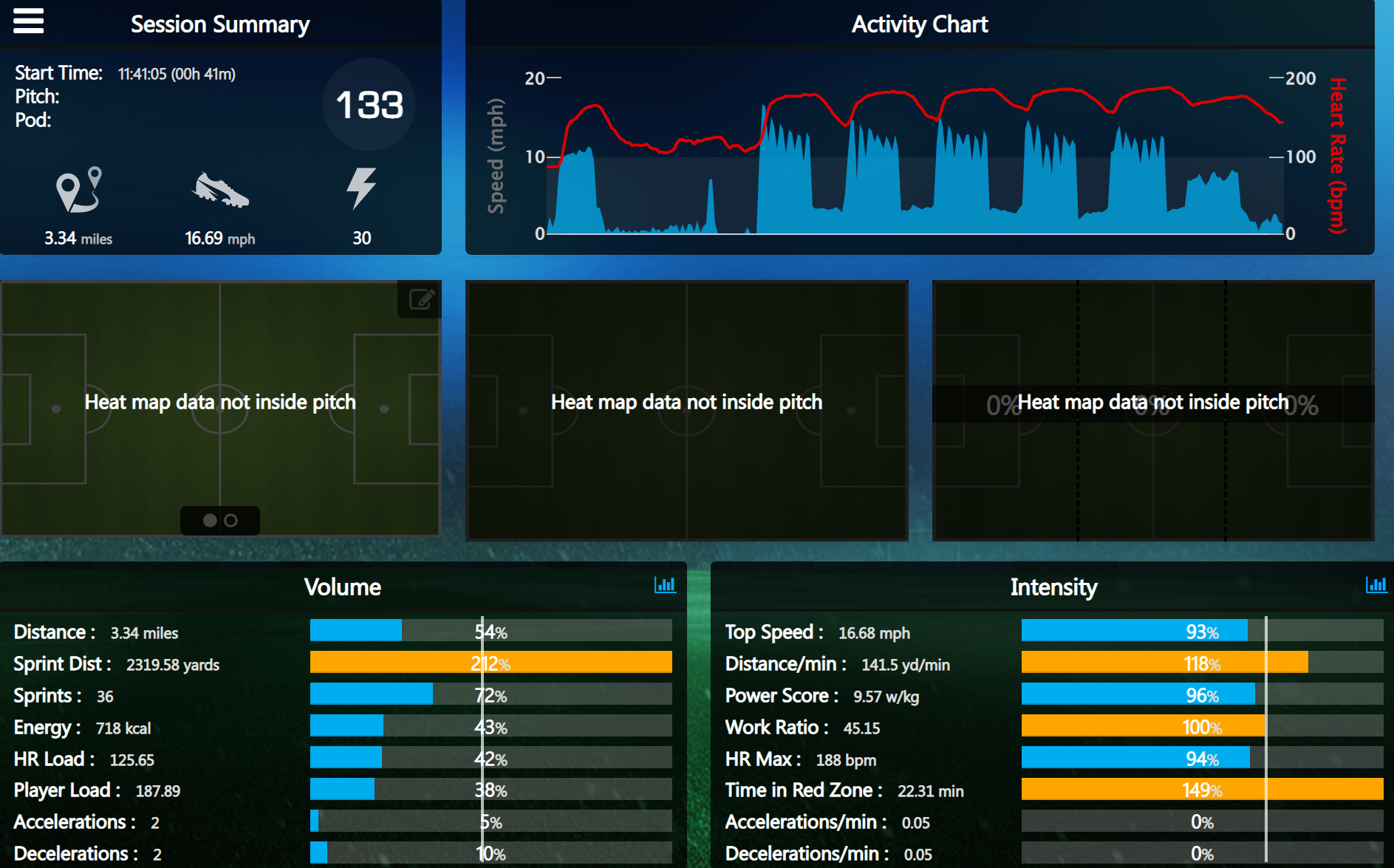Managing Workload During the Season
Whether it’s High School Season, College Season, Professional Season, Off-Season, In Season, or All Seasons. Being able to manage a match workload and training workload is vital for optimal performance and injury prevention.
When it comes to understanding stress or workload on the body there are two important key factors to look at, volume and intensity.
GPS monitoring devices such as Catapult, Playertek, StatSports, and McLloyd Sport calculate the amount of volume and intensity during a match or training session when worn. Heart rate monitoring devices such as Polar, Garmin, and Apple can also be used to measure volume and intensity but won’t provide an accurate score. Being able to incorporate GPS monitoring devices and heart rate devices together will give the best results.
When it comes to volume - we are talking about the overall workload in a match or training session. Each of the above listed GPS devices measure volume by time, distance, sprint distance, number of sprints, energy (in the form of calories/kcal), heart rate load, overall player load, accelerations, and decelerations. Secondly, for intensity - we are talking about the amount of effort or energy used during a given time. The GPS devices measure intensity by top speed, distance travel/min, power score through power output, work ratio, energy (in the form of calories/kcal), and heart rate data in different zone 1-5. Lastly, when it comes to measuring training load with volume and intensity alongside our GPS or heart rate devices, we can use perceived exertion, which is how hard you feel your body is working during exercise.
Now that we have a baseline understanding of workload, let’s look at how a match and training session compare.
For the majority of matches, with a few exceptions here and there, the workload volume will tend to be high, and the workload intensity will be low to moderate. Now, I am not saying that there isn’t any intense sprinting or runs in matches, because there definitely is, however this doesn’t make up the majority of the workload.
On the contrary, when it comes to training sessions, such as MAS Runs (Max Aerobic Speed Runs), Interval Training, Repeated Sprint Training, High-Intensity Runs, and Tempo Runs, the workload intensity will be high, and the workload volume will be low to moderate.
The first image below is GPS and heart rate data taken from a Division 1 Men’s College match. You can see that the workload volume is over 100% on all but one of the key markers. Now, looking at the workload intensity we see only 1 of the key markers is over 100%, with two at 95% mark.
In the second image below, GPS and heart rate data are taken from a MAS Run (Max Aerobic Speed Run). 15sec work/15sec recovery. This run is a 15 second sprint - hitting at least 80 meters, followed by a 15 second recovery jog hitting at least 30 meters. The workout reps/sets for this pace listed above is 6 reps for 5 sets, with a 2 min rest between sets. Overall, this is a 25-minute workout, excluding warm up or cool down. Referring back to the second image, notice how the data changes, only 1 key marker hitting over 100% in the workload volume, while workload intensity is hitting 3 key markers at 100% or more, and the other 3 markers are at 93% or more.
Also, another key marker to observe in the data graphs is the number in the circle in the upper left-hand corner. A score of 100 would indicate 100% effort and load. In the first image the number is 130, in the second image the number is 133. What this means is the individual will need more time to recover than just the standard time, due the amount of overall workload on the body. What is also unique about these two numbers is how a 25-minute MAS RUN has an equal or higher workload and effort than a full 90-minute match!
So onto the real question! How do I manage this training and game workload during the season? To be honest you will have to figure out what works best you, how much time do you need to recover from matches/training sessions, and what are you doing during those recovery days.
I will provide some insight thou. Working as many games as possible during the season, without doing any type of training, and/or some form of active recovery can cause issues. The issues that arise are acute injuries that can turn chronic, staleness in performance, and deconditioning in specific sport training.
We have to give our bodies a physical and mental break. Referees should be able to spread their matches, to allow for adequate rest, active recovery, and proper fitness training. Also being able to monitor what and when we eat are also very important to overall performance and recovery.
As an example, there is a plethora of matches to work during the fall season. As a good rule, pending age, recovery time, diet, etc - as those tend to vary per individual - 2 college matches a week, as the center official and 3 college assistant referees would be adequate. Now you could work 3 centers and 4 assistant referees but then there is an issue of not being fully recovered, muscle soreness, and not being prepared properly.
Being able to manage an overall workload at any point during the year is essential for referee performance. By incorporating GPS, heart rate devices, and self-monitoring into matches and training, referees will be able identify their threshold at an individual level. Dynamic Athlete Training incorporates the analyzing of GPS, heart rate, and perceived exertion data during its elite 12-week customizable referee training program. Referees being able to have this feedback on data will help aid in match and training performance, while also helping aid in recovery and injury prevention.


